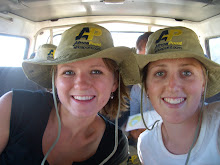After a sad good bye to Heather, Toriann and I were off on our first adventure together to the city of Goreme in the Cappadocia region. This was particularly exciting for me because it meant leaving the Continent of Europe and going to Asia, a Continent I had not yet traveled to! We arrived in Goreme in the morning to be greeted with cold and rainy weather, which neither of us was entirely prepared for. Feeling ambitious and eager to see the sights, we decided to join a tour group right away! We had a very knowledgeable and entertaining tour guy lead us around the Cappadocia region, which was an astonishing sight, and had us continually saying "this is incredible." The Cappadocia region is made up of soft volcanic rock that had been sculpted into pillars, columns and amazing shapes by years of water and erosion. The pliable rock was then further shaped by humans over the years, resulting in stunning caves and underground cities. These underground cities were used first by Greek and Armenian Christians hermits in the 4th century, making it a safe place to hide. Even after the region of Cappadocia was conquered by the Muslims in the 11th century, the Christians were still left mostly undisturbed. One of the remarkable aspects of the underground cities were just how large they were. Even more, they were all built by the inhabitants themselves, not by slaves, which was fairly unheard of for this time period. The underground cities consisted of tunnels, living quarters for humans and animals, wine cellars, bakeries, and ventilation shafts. Not only does the region of Cappadocia have underground cities, but also whole cities were built above ground as well, including the Valley of Ihlara, which was used by the Byzantine monks 1000 years ago. The Valley has dozens of Chapels and Churches carved into the rocks, which the locals call "fairy chimneys," because they look like chimneys. After our all day tour in the cold and rain and rumors of snow the next day we quickly decided we had seen the main sights of the region and it was time to go to Selcuk (Ephesus).
After two nights of overnight buses, and Toriann feeling a bit under the weather, we arrived in Selcuk and spent the morning sleeping. After a good rest we were excited to explore the sunny town. It was a small, but very lively town. The weekend we were there happened to be the weekend of local elections in Turkey. On Saturday there were parades and rallies all throughout the town in support of this event. Through talking with the locals we found out that just about everyone who has an opportunity to vote takes advantage of their right and does so. We found this very admirable, considering it was only local elections, and not even a national election. This is such a contrast to low voter turnout in the US, especially for local elections.
Seeing the ruins of Ephesus were again an incredible sight, it gave us a glimpse of what it would have been like in the Roman times. Ancient Ephesus began being constructed as early as 3BC and continued to expand through the 6th century AD. The ancient town of Ephesus consisted of gymnasiums, churches, libraries, temples, gates, extensive streets, and a great theatre that could hold up to 25,000 people. Ephesus also holds many monuments dedicated to ancient gods and goddess, kings, and the 4 Apostles. We spent an afternoon walking around this eye stricking historical sight and even enjoyed a picnic lunch in the great theater. After our weekend in Selcuk it was time to head back to Istanbul to spend a few more days seeing the city and then off to Greece!
Wednesday, April 1, 2009
Subscribe to:
Post Comments (Atom)

No comments:
Post a Comment